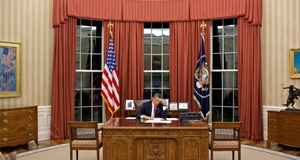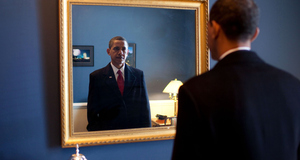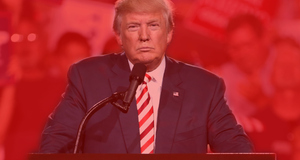Featured Article:Are We All Keynesians Now? Political Ideology and State Deficit Spending in the Great Recession
By
2012, Vol. 4 No. 07 | pg. 1/2 | »
IN THIS ARTICLE
KEYWORDS
The “Great Recession” of 2008 resulted in unprecedented levels of state deficit spending.1 However, even though deficits are partly the result of economic forces beyond the control of state governments—and are at the same time often considered the result of “failures” of policy innovation—one cannot exclude the possibility that states’ fiscal readjustments are in large part determined by the political ideology of their citizens. Indeed, this paper explores the relationship between citizen ideology and states’ levels of deficit or surplus in the years succeeding the recession. Based on the assumption that conservatives will be more likely to value balanced budgets as ends in themselves, and that liberals will be more likely to see deficit spending as necessary for economic recovery, I argue that more liberal states will in general have larger deficits than more conservative states. What follows is a brief review of relevant scholarly literature, along with the theoretical underpinning behind the relationship I anticipate. Theory and Literature ReviewPrevious scholarship on the determinants of fiscal readjustment is surprisingly scarce at the level of U.S. state politics; however, most studies that have been done have found that there is a relationship between ideology and the likelihood that national governments will cut their deficits. Volkerink and de Haan (2001), in an analysis of Organization for Economic Cooperation and Development (OECD) countries, found that conservative governments tended to have lower deficits than liberal governments during the 1970s. Additionally, Tavares (2004) finds that “credibility” is key to the success of deficit-cutting; left-wing governments, which traditionally favor higher taxes and larger government, are more likely to be successful in pursuing fiscal readjustments if they cut expenditures to do it, whereas right-wing governments are more likely to be successful if they raise taxes. Applying this logic, Mierau, Jong-A-Pin, and de Haan (2007) find that left-wing governments are less likely to make fiscal readjustments, since their preferred method of reducing deficits (raising taxes) is more politically difficult in times of economic hardship. Finally, Nice (1986) focuses on deficit spending in U.S. state politics. He finds that states which passed legislation calling for a national balanced budget amendment tended to have a more conservative citizenry than those that did not, but that those states were no more likely to have balanced budget amendments than states that did not call for a national balanced budget amendment. Other studies have found that the ideology of the ruling party in government has little impact on a country’s level of deficit spending in normal economic times (Hahm, Kamlet, and Mowery 1996; Neck and Getzner 2001). Cusack (1999), however, qualifies his finding to this end by noting that it is only in times of economic hardship (high unemployment, diminished growth) that liberal governments are more likely to deficit spend than conservative governments. Since this study focuses on a period of economic woes, these findings are of particular interest.I posit that liberal states are less likely to make harsh fiscal readjustments than conservative states in times of economic hardship, and are thus likely to have had higher budget deficits in the years immediately succeeding the Great Recession. However, I also base this theory on the increasing polarization of liberals and conservatives on the issue of the national debt and deficit, particularly since the high-spending policies under the Obama Administration and the final months of the Bush Administration. These policies—particularly the American Recovery and Reinvestment Act of 2009 (the “stimulus”) and bailouts for the financial and automotive industries—have galvanized fiscal conservative opposition, sparked an intense interest in the national debt and deficit, and resulted in a glorification of balanced budgets as signs of responsibility and as fulfillments of duty to the next generation. As such, I expect that since 2009 especially, conservatives will be more likely to favor lower deficits at the state level as well, and that liberals—traditionally more inclined to favor Keynesian policies of deficit spending to stimulate economic growth—will be more likely to tolerate higher deficits. In short, then, liberal states should be restrained in their willingness to balance their budgets by their proclivity for deficit spending in times of hardship. Thus, aside from having intrinsic relevance in itself, given the still-pressing issues of the national debt and recovery, examining state fiscal policy in the wake of the 2008 recession is a good way of measuring ideology’s impact on fiscal preferences. Times of economic hardship force states to make tough fiscal choices that they might not have to make otherwise and thus reveal underlying fiscal preferences—in average years, there would be far less need to deficit spend (for liberals) and there would be far less variation in state budgets and surpluses (i.e., the dependent variable would have minimal variance). Similarly, the polarization of liberals and conservatives on the issue should mean that ideological variation should have had a strong impact on state deficits in the period following the recession. As for operational definitions, I measure citizen ideology using the index presented by Erikson, Wright, and McIver (2006), who compiled the index using CBS/New York Times polls from 1996 to 2003. This number is used as my independent variable, with higher numbers indicating higher levels of liberalism. In order to measure my dependent variable—the intensity of state budgetary shortfalls—I divide a state’s year-end balance by its total expenditures for the fiscal years 2009 through 2011, with data obtained from The Book of the States (Council of State Governments 2010; 2011).2 I then combine these values for all three years, with positive values indicating overall deficits and negative values indicating overall surpluses. Finally, since dependence on tourism or on the extraction of mineral resources might insulate states from the need to make fiscal adjustments by granting them a stable source of income, I control for these two revenue sources. To do so, I measure tourism dependence by using the percentage of states’ revenue that comes from sales taxes, as states that rely heavily on tourism would be likely to have higher sales taxes in order to maximize the benefits of their natural advantages. I measure mineral extraction dependence using the percentage of state revenue that comes from sources other than sales taxes or property taxes (classified by the Tax Foundation as “Licenses and Other Taxes”). For many states, a significant portion of this revenue is made up by income obtained through the sale of natural resources.3 Thus, I hypothesize that there will be a positive relationship between a state’s level of liberalism and its level of deficit spending between 2009 and 2011. In order to test this hypothesis, I use pairwise correlations to determine the relationship between my independent and dependent variables, and then in order to control for the effects of the sources of state revenue, I use linear regression analysis. AnalysisA preliminary analysis of the data upholds this study’s expectations. As indicated in Figure 1 and Table 1, the relationship between state ideology and state budgetary shortfalls is moderate, but higher levels of citizen liberalism are associated with higher levels of state deficits, with a correlation of 0.203.4 Similarly, reliance on revenue from mineral extraction has a moderately strong negative relationship (coefficient of -0.233) with deficit spending. Interestingly, however, higher levels of revenue obtained through sales taxes do not appear to have a moderating effect on state deficits; rather, higher sales tax revenue is associated with higher state deficits. This could potentially mean that states that typically rely on a great deal of tourism revenue were disproportionately affected by the recession than states that do not, perhaps because tourists put off their visits during the hard times. Table 1: Pairwise Correlation Coefficients (N=50)
A look at Figure 1 reveals an intriguing dimension of the relationship between ideology and deficits (see also Tables 4 and 5, in Appendix). In the left half of the graph (the “conservative half”), there is considerable variation on the dependent variable—a number of states had extremely high budget surpluses, though only two had an overall budget deficit for the three-year period. In the “liberal half” of the graph, however, one sees far less variation, with all but three states within a range of -10% and 10% total deficit. Indeed, the twenty-five conservative states’ deficit values have a range of 58.83 and a standard deviation of 15.44, compared to the liberal states’ range of 42.334 and standard deviation of 10.78. The disparity is even greater if one throws out the two outlier liberal states with deficit ratings of less than -30% (Nebraska and Tennessee), as the range then becomes 14.79, with a standard deviation of 5.35.
In short, then, the relationship between ideology and state deficits is not a linear one. While state surpluses tend to rapidly decrease as liberalism increases, this relationship tapers off once one reaches the “moderate” and “liberal” states in the middle and right areas of the graph. One explanation for this could be that conservatives are highly averse to deficit spending as expected, but that liberals, while less averse, are not necessarily favorable toward it—at least at the state level. Thus, the relationship presented here seems to be less the result of a liberal proclivity for deficits and more the result of conservative antipathy for them. Moving to regression analysis, Table 2 shows that there is, as expected, a significant and fairly strong relationship between state ideology and deficits, even while controlling for licensing and sales tax revenue. More liberal states tend to have higher deficits than more conservative states; indeed, for every one-point increase in state liberalism, state deficits increased an average of over two percent for the period from FY2009 to FY2011. Nevertheless, contrary to my expectations, sales tax revenue is yet again associated with higher deficits, with every one percent increase in state sales tax revenue accompanied by a 2.6 percent increase in a state’s tri-year deficit.5 Table 2: The Effects of Ideology and Revenue Sources on State Deficits (N=50)
Because of this unexpected positive relationship between sales tax revenue and deficit levels, I decided to run a second regression analysis. This time I control for states’ level of economic growth, as states that fared better economically during the recession would both have had less need to deficit spend and would have presumably seen a smaller drop in tax revenue than a state whose economy contracted dramatically. In order to measure states’ relative economic growth during the recession, I look at each state’s rate of real gross state product (GSP) change for FY2009 and FY2010 and then combine the two, with higher numbers indicating higher levels of growth.6 Additionally, I also control for states’ level of direct democracy, as ballot initiatives (e.g., California’s Proposition 13) can greatly limit a state’s ability to make fiscal readjustments in times of economic crisis. Indeed, the evidence suggests that initiative states are more likely to have caps on taxation and supermajority requirements for tax increases, which would constrain a state’s ability to raise revenue in times of economic crisis. At the same time, however, initiative states have also been more likely to have expenditure caps, which would limit the state’s ability to deficit spend (Smith and Tolbert 2007: 422-423). Thus, a high level of unrestrained direct democracy could have an impact both on a state’s ability to spend and especially on its ability to tax. In order to measure direct democracy, I use a dichotomous variable to indicate whether a state has an initiative process, with 0 indicating that it does not and 1 indicating that it does. After controlling for growth and direct democracy, the regression coefficients remained largely unchanged (see Table 3). Ideology still has a positive, significant effect on state deficit levels. Similarly, high levels of economic growth are associated with lower deficits and the presence of ballot initiatives with higher deficits, as expected, though the relationships are not statistically significant. However, this time sales tax revenue just barely misses the 0.05 significance level. Thus, ideology is the only independent variable that had a substantial and significant effect on state deficits between 2009 and 2011. Table 3: The Effects of Ideology, Revenue Sources, Growth, and Direct Democracy on State Deficits (N=50)
ImplicationsOn the whole, then, the data supports the hypothesis presented here: conservative states were likely to have smaller deficits and larger surpluses than liberal states were in the three years that succeeded the Great Recession. However, the strength of association between the two variables is not quite as strong as might be expected. What follows is a brief discussion of what could have dampened the effect of ideology upon state fiscal adjustments during the recession.Continued on Next Page » Suggested Reading from Inquiries Journal
Inquiries Journal provides undergraduate and graduate students around the world a platform for the wide dissemination of academic work over a range of core disciplines. Representing the work of students from hundreds of institutions around the globe, Inquiries Journal's large database of academic articles is completely free. Learn more | Blog | Submit Latest in Political Science | |||||||||||||||||||||||||||||||||||||||||||||||||
















